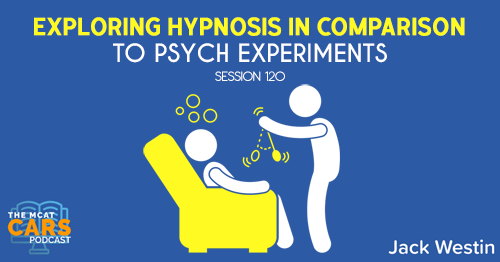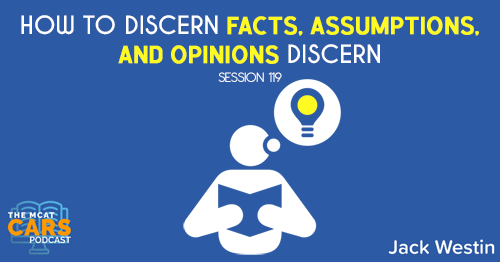Apple Podcasts | Google Podcasts

Session 63
The key to answering CARS questions is to think like the author of the passage. Today, we have a very descriptive article. This is the kind of article that scares a lot of ESL (English as a Second Language) students. Try to read this passage on your own first, then follow along.
We’re joined once again by Jack Westin, the premiere MCAT CARS tutor.
Link to article:
https://getpocket.com/explore/item/things-that-go-bump-in-the-wild
When you’re little, the basic laboratory of scariness and mystery is a tent in the backyard. The 30 feet from the tent flap to the back door spans an immeasurable distance, mentally; a ghost story told at the kitchen table is an anecdote, while the same story told by flashlight late at night in the tent howls with the darkness all around. Love and learning and charity may begin at home, but, for most humans, fear begins outside.
As a young man, I sometimes used to fantasize about how great it would have been to wander the American continent before civilization ruined it. I dreamed of seeing the Great Lakes before industrial pollution, the Appalachian hills before strip mining, the Great Plains before the railroad, etc. The fantasy has been common in the years ever since most real American wilderness disappeared. At the end of the movie Shakespeare in Love, for example, Gwyneth Paltrow walks slowly from the sea across a broad, white beach in the 1590s, a horizon ahead of her as big as the American future. The actual people who saw that kind of horizon didn’t react to it with joyful anticipation all the time. They didn’t know the Great Lakes and the Plains and the Rockies were out there. They saw only the dark tree line at the border of their stump-filled clearings, and they were afraid.
Anything could be out there, anything at all. The first Europeans on the land didn’t have the science to conjure UFOs in the wilderness, but they certainly had the theology to imagine a wilderness of devils, a boundless waste occupied by Satan and his works. The most wild-eyed among the settlers wouldn’t even admit the consolation of shared humanity between themselves and the original inhabitants; in the words of Cotton Mather, the Puritan divine, American Indians weren’t human; they were “tawney serpents.” The terror of the unknown continent took physical form in these presumedly wild men. Indian raiders would sometimes descend on frontier cabins like a sudden localized hurricane and, after dreadful, fast destruction, disappear with captives of whom no trace would ever be found, except maybe a baby’s bonnet, a piece of ribbon, or the blue eyes of a half-Indian child met at a trading post years later.
Mysteries terrify, especially mysteries that extend from who-knows-where right to the edge of town. The progress of us new arrivals clear across the country has been a persistent attempt to stamp out the mysteries and submerge them under pastures and softball fields. For some reason, people can accept the worst mishaps and violence in built-up places, and yet still become electric with fear at the thought of getting jumped by a wild creature in a place without roads. As anxiety sufferers know, ordinary fears, even bad ones—fear of your husband leaving, of financial reversal, of news from the doctor—can seem small and manageable compared with the dizzying spiral of unspecified fear that bores through you when you have nothing real to be afraid about.
One evening, several friends and I were walking along a wooded trail on our way back from fishing at Argyle Lake, in a rural part of central Illinois. The subject of the Argyle Monster, a local legend, came up. Dave said he had seen it once, at a distance. Rick said it had once followed him through the woods for several miles. They described it as a large cougar that walked on its hind legs because both of its front paws had been damaged in a trap. Also, they said, the Argyle Monster screamed like a woman. Half kiddingly, I was asking them for more particulars. At that moment we came around a bend and heard a weird sound. We saw where it was coming from, but at first, couldn’t make sense of what we were seeing.
[04:05] Paragraph 1, Sentence 1
When you’re little, the basic laboratory of scariness and mystery is a tent in the backyard.
Jack says:
The author is setting up the scene of scariness and mystery. You can imagine being a kid.
[04:40] Paragraph 1, Sentence 2
The 30 feet from the tent flap to the back door spans an immeasurable distance, mentally; a ghost story told at the kitchen table is an anecdote, while the same story told by flashlight late at night in the tent howls with the darkness all around.
Jack says:
This is a pretty long sentence. So it’s better to stop at the semi-colon. Then you can keep reading. So the author is making the comparison that telling the ghost story in the kitchen is not as scary as it would be outside in the darkness. They’re comparing the kitchen and the tent. Being able to visualize this is very important.
[06:25] Paragraph 1, Sentence 3
Love and learning and charity may begin at home, but, for most humans, fear begins outside.
Jack says:
The author is talking about fear outside as the common theme in this entire paragraph.
[07:28] Paragraph 2, Sentence 1
As a young man, I sometimes used to fantasize about how great it would have been to wander the American continent before civilization ruined it.
Jack says:
The author is painting the picture of wandering the U.S. before civilization tolled. Civilization ruining America is an opinion. Understand that even if the author presents it as a fact, it’s not.
'Many students have a hard time distinguishing facts from arguments. You're responsible for knowing the difference as you read passages.'Click To Tweet[08:05] Reminder: Think Like the Author
Students have a difficult time distinguishing between facts and arguments because as students, we’re trained whatever the teacher gives us. So here, you never think about its validity whether or not it’s a good thing to agree with this idea.
With CARS, the game is totally different. You’re not supposed to memorize. You’re supposed to understand and contemplate whether or not you as an individual agrees or disagrees with it.
But that said, you have to be thinking like the author as you’re answering the questions. Sure, you can debate and think about it when you’re reading. It’s as if it was a conversation.
'When you get to the questions, you must think like the author.'Click To TweetWhen you get the Jack Westin course, you will be taught how to break things down and understand what the sentence is doing. Asking why the author is bringing things up is really important.
[10:06] Paragraph 2, Sentence 2
I dreamed of seeing the Great Lakes before industrial pollution, the Appalachian hills before strip mining, the Great Plains before the railroad, etc.
Jack says:
The author is giving an example of what he was talking about in the previous sentence.
[10:23] Paragraph 2, Sentence 3
The fantasy has been common in the years ever since most real American wilderness disappeared.
Jack says:
You just have to understand that the author is pessimistic about how civilization interacts with America or the continent.
[11:04] Paragraph 2, Sentence 4
At the end of the movie Shakespeare in Love, for example, Gwyneth Paltrow walks slowly from the sea across a broad, white beach in the 1590s, a horizon ahead of her as big as the American future.
Jack says:
The author is again very positive towards no human interaction.
[11:50 Paragraph 2, Sentence 5
The actual people who saw that kind of horizon didn’t react to it with joyful anticipation all the time.
Jack says:
The people back in the day didn’t enjoy it.
[12:22] Paragraph 2, Sentence 6
They didn’t know the Great Lakes and the Plains and the Rockies were out there.
Jack says:
They don’t know. Just imagine someone who’s out exploring.
[13:00] Paragraph 2, Sentence 7
They saw only the dark tree line at the border of their stump-filled clearings, and they were afraid.
Jack says:
It ties back to being outside and being afraid. The author is trying to make this assumption that we have ruined civilization. And we’re not going to be as surprised or as fearful of it because we know more about it now.
That author wants you to know that if you don’t know something or not aware of it, it scares you. As a side note, America is ruined by civilization.
[14:03] Paragraph 3, Sentence 1
Anything could be out there, anything at all.
Jack says:
The author is painting a picture of the unkown.
[14:16] Paragraph 3, Sentence 2
The first Europeans on the land didn’t have the science to conjure UFOs in the wilderness, but they certainly had the theology to imagine a wilderness of devils, a boundless waste occupied by Satan and his works.
Jack says:
The author is painting fear in terms of satan and UFOs. But it’s still fear.
[15:04] Paragraph 3, Sentence 3
The most wild-eyed among the settlers wouldn’t even admit the consolation of shared humanity between themselves and the original inhabitants;
Jack says:
The author says that even the most adventurous don’t want to admit that the original inhabitants are like them. So we’re not just afraid of animals but also UFOs and things we’re not accustomed to.
[16:40] Paragraph 3, Sentence 4
in the words of Cotton Mather, the Puritan divine, American Indians weren’t human;
Jack says:
Cotton Mather is probably someone special and they’re not humans. Tying this to the previous sentence, we couldn’t have shared humanity because we didn’t see them as humans.
[17:22] Paragraph 3, Sentence 5
they were “tawney serpents.”
Jack says:
They’re basically serpents.
[17:39] Paragraph 3, Sentence 6
The terror of the unknown continent took physical form in these presumedly wild men.
Jack says:
There’s terror of the unknown and that fear is pushed on to the native Americans.
[18:09] Paragraph 3, Sentence 7
Indian raiders would sometimes descend on frontier cabins like a sudden localized hurricane and, after dreadful, fast destruction, disappear with captives of whom no trace would ever be found, except maybe a baby’s bonnet, a piece of ribbon, or the blue eyes of a half-Indian child met at a trading post years later.
Jack says:
It’s an example of where that fear came from – the native Indians raiding the cabins. The fear from the wilderness even applies to native Americans.
[18:57] Paragraph 4, Sentence 1
Mysteries terrify, especially mysteries that extend from who-knows-where right to the edge of town.
Jack says:
Again, the author is painting that picture of fear of the outside.
[19:23] Paragraph 4, Sentence 2
The progress of us new arrivals clear across the country has been a persistent attempt to stamp out the mysteries and submerge them under pastures and softball fields.
Jack says:
We’re trying to be less scared of the unknown by putting pastures and making softball fields. It’s civilization.
[20:04] Paragraph 4, Sentence 3
For some reason, people can accept the worst mishaps and violence in built-up places, and yet still become electric with fear at the thought of getting jumped by a wild creature in a place without roads.
Jack says:
Again, the author is talking about the fear of the outside in the wilderness.
[20:37] Paragraph 4, Sentence 4
As anxiety sufferers know, ordinary fears, even bad ones—fear of your husband leaving, of financial reversal, of news from the doctor—can seem small and manageable compared with the dizzying spiral of unspecified fear that bores through you when you have nothing real to be afraid about.
Jack says:
The author is giving another example of fear of the unknown versus the fear of everyday things you might expect. It’s trying to say that the fear of the wilderness is not that big of a deal but we make it a big deal. While these other things are not that scary for us.
[21:20] Paragraph 5, Sentence 1
One evening, several friends and I were walking along a wooded trail on our way back from fishing at Argyle Lake, in a rural part of central Illinois.
Jack says:
It’s a pretty straightforward sentence here.
[21:34] Paragraph 5, Sentence 2
The subject of the Argyle Monster, a local legend, came up.
Jack says:
The author is now mentioning the monster.
[21:44] Paragraph 5, Sentence 3
Dave said he had seen it once, at a distance.
Jack says:
One person said he saw it once at a distance.
[21:52] Paragraph 5, Sentence 4
Rick said it had once followed him through the woods for several miles.
Jack says:
Another description here.
[21:58] Paragraph 5, Sentence 5
They described it as a large cougar that walked on its hind legs because both of its front paws had been damaged in a trap.
Jack says:
It’s a good campfire story here.
[22:12] Paragraph 5, Sentence 6
Also, they said, the Argyle Monster screamed like a woman.
Jack says:
The author gives more description of the monster.
[22:22] Paragraph 5, Sentence 7
Half kiddingly, I was asking them for more particulars.
Jack says:
The author is trying to get more information.
[22:30] Paragraph 5, Sentence 8
At that moment we came around a bend and heard a weird sound.
Jack says:
And more description.
[22:36] Paragraph 5, Sentence 9
We saw where it was coming from, but at first couldn’t make sense of what we were seeing.
Jack says:
The author is just telling this story of what seems like a folktale born from this fear of the wilderness and fear of the outside.
[23:08] The Main Idea
This is an example that our greatest kind of fears come from this unknown wilderness. The author is trying to paint an ironic example. They know it’s big and they’re joking about it. But as soon as they hear something outside the wilderness, they’re up on their feet and worried about it.
The author is saying that no one can escape this fear of the wilderness. The author picked a more descriptive writing style to get there.
[24:30] Final Thoughts
You don’t need to understand every word to know the general force of this passage. Just keep reading and try to understand whenever you can and you should be okay.
Don’t give up halfway through just because you saw a couple of sentences you don’t understand. Keep track of your ideas. Practice, practice, practice!
'If you know how to pick up the right important information, the sentences around it don't really matter much.'Click To Tweet[26:48] Jack Westin
Jack Westin is coming up with another course at the end of January. This is perfect for students looking to take the MCAT in April, May, or June. If you really want to see some improvements, prepare months in advance.
'If you're really serious about improving your CARS score, start sooner than later.'Click To TweetIf you’re practicing and you’re already at 127 or 128, just keep doing what you’re doing. No need to change anything and just keep at it!
Sign up earlier to get the assistance and support you need. Even if your course ends, they will still give you support. Get free daily CARS passages right to your email inbox.
Links:
Get your free daily CARS passages!
Link to article:
https://getpocket.com/explore/item/things-that-go-bump-in-the-wild
SEARCH SITE
SEARCH SITE
LISTEN FOR FREE











